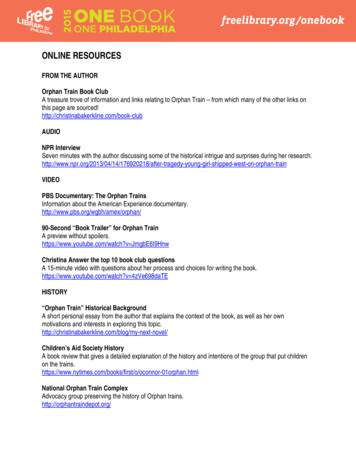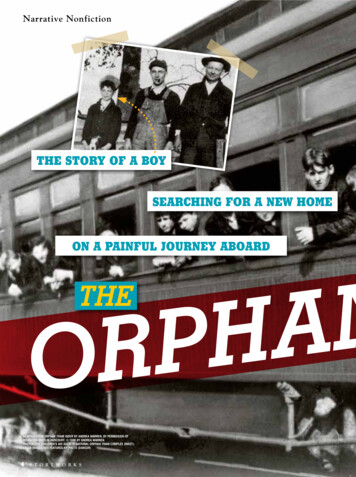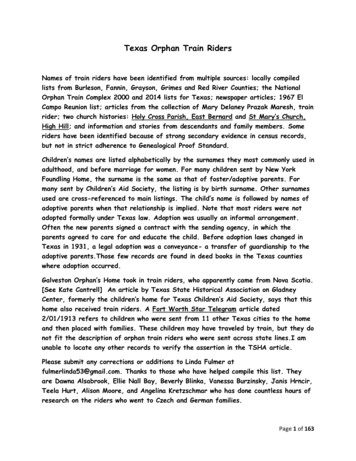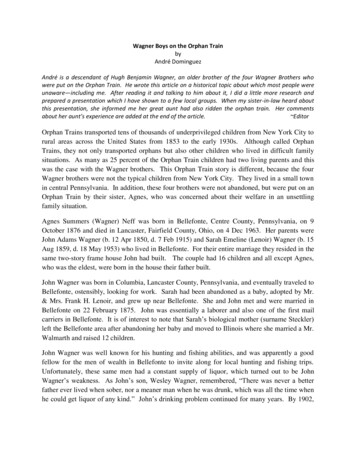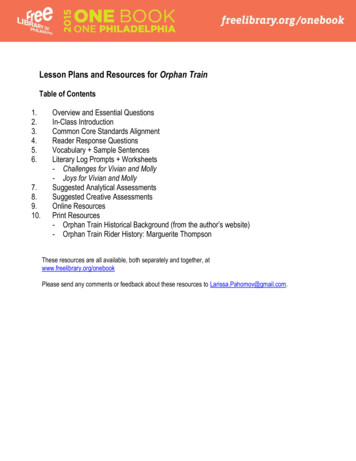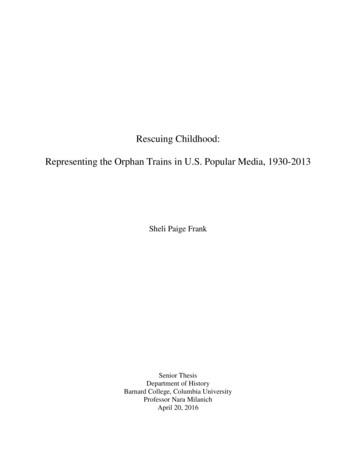
Transcription
“Defeat Is an Orphan”The Kennedy Administration and the BureaucraticTug-of-War over the Bay of PigsEric R. MartellPresident John F. Kennedy meets with the Joint Chiefs of Staff, January 25, 1961Foreign policy creation is a dialectical discourse. In an uncertain post-9/11 worldreplete with threats of transnational terrorism, international narcotics trafficking, and persistent border crises, the domestic debate over foreign policy is perhaps more acute than ever. Within the councils of government, the nature of thenation’s relationship to the rest of the world is inherently a dialogue between competing ideas. Whether warning of “entangling alliances” as in George Washington’sfamous farewell address or in promoting notions of interventionism, empire, andglobalization, the development of foreign policy requires the critical exchange ofEric R. Martell is a Ph.D. student in the Department of History at the University at Albany, SUNY wherehis work engages with the interplay between private business and public policy in foreign relations withLatin America. “Defeat is an Orphan” began as his bachelor’s thesis at SUNY Potsdam. He especiallywould like to thank the Presidential Scholars program and Professors Kevin Smith and Thomas Bakerfor their knowledge, guidance, and support in producing this piece. He is also grateful for the insightfulcomments and suggestions from his graduate community, his Albany instructors, and Ellen.87
88 Federal History 2017ideas. Exploring the process of policy creation can be quite useful for studying theAmerican federal government and how it responds to exogenous and endogenouspressures around the world and at home.One particularly illuminating episode of foreign policy creation as a dialecticaldiscourse is the failed invasion of Cuba in 1961 to unseat Fidel Castro. Well understood by students and scholars alike, the invasion at the “Bay of Pigs” famouslyfloundered upon arrival. What is less understood, however, and is hotly debatedamongst scholars, is why it unfolded in the manner it did. As Rebecca Friedmanpoints out, scholars have identified four proximate explanations: the unfamiliarityamong President John F. Kennedy’s advisers, the secrecy involved, the decisionmaking structure, and “perverse” bureaucratic dynamics.1 Whereas Friedman posits the importance of the transition period between Dwight Eisenhower and JohnKennedy, this essay, concedes the significance of the transition months but arguesthat the primary reason for the invasion’s failure was the perverse bureaucraticdynamics.In carrying forward a plan inherited from the Eisenhower administration,Kennedy approved what he thought to be a guaranteed victory. Both administrations, however, wrestled bureaucratically over the clandestine operation’splanning and execution. To understand the operation and the debates withinthe Kennedy administration this essay examines the planning and approvalprocesses through two lenses: the bureaucratic politics model hypothesizedby Graham T. Allison in 1971 and Groupthink Syndrome as articulated bythe noted Yale psychologist Irving Janis.2 Separately, these models do notadequately explain the outcome of the invasion, but together, they supplement and compensate for the other’s deficiencies. Groupthink, for example,explains what Allison’s model cannot: the psychological pressures placed onpolicymakers at the critical moment of decision. Allison’s model, on the other side, complements Janis’s paradigm by providing a theoretical frameworkfor explaining the process of bureaucratic planning. By fusing these models,scholars can better understand not only why the invasion failed, but also why1Rebecca R. Friedman, “Crisis Management at the Dead Center: The 1960–1961 Presidential Transition and the Bay of Pigs Fiasco,” Presidential Studies Quarterly 41 (June 2011): 307–33. She argues thata fifth category ought to exist, one that focuses on the transition period from Eisenhower to Kennedy,and that this lame duck period was the primary determining factor in the invasion’s defeat.2Graham T. Allison, Essence of Decision: Explaining the Cuban Missile Crisis (Boston: Little Brown,1971); Irving L. Janis, Victims of Groupthink: A Psychological Study of Foreign-policy Decisions andFiascoes (Oxford: Oxford University Press, 1972).
“Defeat Is an Orphan” 89it went forward with far too little critical analysis of its shortcomings that wereobvious to many of the planners. More broadly, such investigations demonstrate that historians can find utility in applying theories from the other socialsciences and humanities in their analyses. Understanding the winding processof Operation Bumpy Road, as the invasion was known, can permit scholarsto better appreciate our contemporary presidential methods of foreign policydecision-making and public policy creation more broadly.The Bureaucratic Politics and Groupthink ApproachesGraham T. Allison theorized bureaucratic politics analysis in 1972 as a way tounderstand Kennedy’s famous success in the Cuban Missile Crisis of 1962. In1984, however, scholar Lucian Vandenbroucke applied the same bureaucraticlens to the Bay of Pigs—a famous Kennedy failure. Vandenbroucke held deepreservations about the total usefulness of the model due to the paucity of primary evidence in the mid-1980s but did accept its three key assumptions.3First, there are many competing rational actors representing different parts ofthe bureaucracy with policy preferences that are driven by Miles’s Law.4 Additionally, theorists argue that bureaucrats attempt to defend their organizations’budgets, responsibilities, and discipline in a phenomenon called “organizationalparochialism.” Second, these competing rational actors engage in “bargaining”in which each actor negotiates and compromises in a game of “push-and-pull”politics. Third and finally, the model assumes that all government decisions area “resultant” of this bargaining game and that decisions are simply a series ofcompromises.In Allison’s model, the power of the decision-maker is checked by the power ofthe decision-implementers. Accordingly, the president is the only superpoweramong lesser players representing different departments or agencies. “The moves,sequence of moves, and ‘games of chess’ are thus to be explained in terms of thebargaining among players with separate and unequal power over particular pieces,and with separable objectives in distinguishable sub games,” wrote Allison.5 Oneof the defining qualities of Allison’s theory is that in terms of quantity and qualityof power, players can be colloquially divided into two categories: “heavy-weights”Lucien S. Vandenbroucke, “Anatomy of a Failure: The Decision to Land at the Bay of Pigs,” PoliticalScience Quarterly 99 (Autumn 1984): 471–91.4Miles Law, “Where you sit (your position) in the bureaucracy will determine your stand(your policy preferences).” See: Rufus E. Miles, Jr., “The Origin and Meaning of Miles’ Law,” PublicAdministration Review 38 (1978): 399–403.5Allison, Essence of Decision, 163.3
90 Federal History 2017and “light-weights.”6 Thus, decision-making is a game in which players of unequalstrength barter and negotiate with other players, all the while contending withthe executive whose power trumps all, but is concomitantly held in check via thenegotiated relationship.7The most serious shortcoming of Allison’s model, however, is that it only describes thedecision-making process and does not adequately account for the actual decision itself.Groupthink Syndrome, on the other hand, is an efficacious way to solve this deficiency asit addresses the rationality and psychological dynamics of group-based decision-making.The founding theorist, Irving Janis, defines groupthink as “a quick and easy way to referto a mode of thinking that people engage in when they are deeply involved in a cohesive in-group, when the members’ strivings for unanimity override their motivations torealistically appraise the alternative courses of action.”8 The theoretical premise is rathersimple: when grouped together, people naturally try to agree and find commonality, andwhen too many people in the group attempt to find concurrence, any healthy criticism,dissension, and debate is lost because of an atmosphere of “relaxed conviviality.”9Groupthink Syndrome can explain the decision itself while the Bureaucratic Politicsmodel explains the preceding discursive process. The resulting fusion of the two models enhances explanatory power. This combined Bureaucratic-Groupthink model candemonstrate that those policymakers involved in the creation and approval of the 1961invasion failed to be critical of the plan’s evident shortcomings and can further illuminate the process of dialectical discourse by showing how it broke down within theKennedy administration.The Planning StagesOrganizations like the Central Intelligence Agency (CIA) tend to follow past templates to deal with present and future problems. The Bay of Pigs invasion was mod6For excellent criticism of Allison on this point, with which I concur, see David Welch’s work “TheOrganizational Process and Bureaucratic Politics Paradigms: Retrospect and Prospect,” InternationalSecurity 17 (Fall 1992): 112–46; Vandenbroucke, “Anatomy of a Failure: The Decision to Land at theBay of Pigs,” 471–91; and the inquisitive 1992 work of Jonathan Bendor and Thomas Hammond,“Rethinking Allison’s Models,” American Political Science Review 86, no. 2 (1992): 301–22.7This is similar, on a much smaller and intragovernmental level, to the construction of hemispherichegemony by the United States as articulated by William Roseberry’s chapter, “Hegemony and theLanguage of Contention,” in Everyday Forms of State Formation: Revolution and the Negotiation of Rulein Modern Mexico, 355–66, eds., Gilbert M. Joseph and Daniel Nugent (Durham: Duke UniversityPress, 1994). In it he argues that hegemony is contested, negotiated, and fluid.8Janis, Victims of Groupthink, 9.9Ibid., 3.
“Defeat Is an Orphan” 91eled after Operation PBSUCCESS in which the CIA worked to oust Guatemala’sleftist president Jacobo Arbenz in 1954. The Guatemalan overthrow was poorlyplanned and was only adequately executed, but conditions within Guatemalaallowed it to succeed.10 Seven years later, when trying to convince Kennedy that theinvasion of Cuba should proceed, CIA Director Allen Dulles said he felt more confident than he had with Guatemala.11 Dulles’s words weighed heavily on Kennedy,who evidently was unaware that reality did not match his presidential briefings—that the exiles were poorly trained, supplies were limited, and Castro was on alert.12Piero Gleijeses notes that CIA officials were so “elated” in the wake of 1954 that “theyforgot the many ways that they knew it could have gone wrong.”13 The brimmingoverconfidence within the CIA prevented any objective internal review, and its officials were, by 1961, unaware of the inferior nature of their template.14The plan Kennedy approved in March 1961 was drastically different from the planthat Eisenhower sanctioned a year earlier. In March 1960, Eisenhower authorized asmall guerilla infiltration with the goal of training disloyal Cubans to openly rebeland march on Havana.15 Kennedy was subsequently asked to approve a World WarII–style maritime invasion. Coinciding with the presidential transition as hypothesized by Friedman, the decision-making process by which the invasion morphedfrom guerrilla-infiltration to a covert amphibious landing doomed the entire project. Therefore, until the final moment of failure, Kennedy continued to believethat popular uprisings would indeed occur and that guerilla operations were stillbeing conducted on the island.Vandenbroucke, “Anatomy of a Failure,” 474; see also Piero Gleijeses’s Shattered Hope: TheGuatemalan Revolution and the United States, 1944–1954 (Princeton: Princeton University Press, 1992).11Theodore C. Sorensen, Kennedy (New York: Harper & Row, 1965), 296.12Castro had imprisoned or exiled most of the opposition groups, thereby destroying theunderground networks that would have otherwise aided the invasion. Kennedy remained uninformedon the matter until February; see: “Proposed Operation Against Cuba,” Foreign Relations of theUnited States (hereinafter abbreviated FRUS), 1961–1962, Vol. X, Cuba: January 1961–September1962, eds., Louis J. Smith and David S. Patterson (Wash., DC: Government Printing Office (GPO),1997), Doc. 58; see also “Revised Cuban Operation,” FRUS, Vol. X, Doc. 61; “Cuban Operation,”FRUS, Vol. X, Doc. 93; “Cuba,” FRUS, Vol. X, Doc. 27; and “Joint Chiefs Security Memoranda57–61: Military Evaluation of the Cuban Plan,” FRUS, Vol. X, Doc. 35; all make an unequivocalcase to the president that the invading forces would be welcomed and joined by the Cuban populace.13James G. Blight and Peter Kornbluh, eds., Politics of Illusion: The Bay of Pigs Invasion Reexamined(London: Lynne Rienner Publishers, 1988), 41; see also Piero Gleijeses, Shattered Hope for a more indepth analysis of the coup and his 1995 article “Ships in the Night: The CIA, the White House and theBay of Pigs,” Journal of Latin American Studies 27 (Feb. 1995): 1–42.14Gleijeses, Shattered Hope, 376.15Gleijeses, “Ships in the Night,” 3.10
92 Federal History 2017Why, in light of the operation’s metamorphosis, did Kennedy continue to believethis to be true? Allison’s bureaucratic politics model provides the answer: organizational parochialism. The term is defined as the desire to promote, defend, andenhance the agency’s turf and reputation, and explains the CIA’s ability to possess a monopoly over intelligence and then control the flow of information to theWhite House.In a memo sent by Col. Jack Hawkins to Jake Esterline in the CIA’s WesternHemisphere Directorate for Plans in the first week of 1961, the agency noted thatpopular uprisings in Cuba were requisite for success. This came after the invasion’s conception had turned away from a guerilla-based program and toward anamphibious Normandy-styled landing. The memo read: “There will be no earlyattempt to break out of the lodgment for further offensive operations [meaningproceeding to Havana] unless and until there is a general uprising against the Castroregime or overt military intervention by United States forces has taken place.”16This crucially important statement from the CIA was the basis of JFK’s eventual,albeit apprehensive, approval. The CIA promised a Cuban uprising and defectionsfrom Castro’s own military. The CIA argued that in case revolts did not materialize the United States could recognize a provisional government in Cuba afterthe brigade took enough physical territory. After recognition, the president couldauthorize overt American intervention on behalf of an ally.17In addition to the CIA’s monopoly of information, Director Allen Dulles andRichard Bissell, the invasion’s mastermind and the agency’s deputy director ofplans, advocated for their own plan and tried to sell it to the incoming presidentand his new advisers. In doing so, they prevented an objective review of theirblueprint. As part of their monopoly that relegated Pentagon officials to the roleof outside evaluators, Dulles and Bissell also blocked contradictory intelligenceoriginating in other parts of the CIA from making its way outside the confinesof agency headquarters.18 Equally nefarious, Bissell prevented information from“Policy Decisions for Conduct of Strike Operations Against Government of Cuba,” FRUS, Vol.X, Doc. 9.17Ibid.18Intelligence briefings that argued the Cuban underground was in shambles and that revolts wouldnot occur were never sent to the White House. In addition, officers in charge of implementing theplan and training the guerilla fighters expressed doubts that were never relayed outside of the CIA. Infact, the planners Jake Esterline and Jack Hawkins traveled to the home of Richard Bissell to expresstheir reservations and their desire to resign from their posts over the latter’s stifling of their objections.See: Don Bohning, The Castro Obsession: US Covert Operations Against Cuba, 1959–1965 (Wash., DC:Potomac Books, 2006), 32–36.16
“Defeat Is an Orphan” 93being passed between policymakers and policy implementers. One CIA officialnoted that Bissell “deliberately kept us in the dark until the last minute” after thatparticular officer expressed severe doubts about the operation.19 Instead, Bissellrelied upon hand-chosen evidence that supported his view of Castro’s power, thereadiness of the expatriate army, and his own worldview. This evidence, however,was based on intelligence that greatly underestimated Castro’s military strengthand overestimated the likelihood of average Cubans rising up and marching toHavana to oust the bearded leader.20When questioned about the conceptual change years later, Bissell stated that theoriginal plan would not have “produce[d] a psychological effect sufficient to precipitate general uprisings or wide-spread revolt among disaffected elements of Castro’sarmed forces.”21 With a new chief executive in John F. Kennedy, Bissell promoteda Normandy-style amphibious landing that he believed would indeed precipitateuprisings across the island against Castro. In reality, however, the invasion plans hadevolved because of declining support for rebels throughout Cuba as articulated byinteragency intelligence estimates. The agency’s stranglehold over the intelligencereports that made it to the president’s desk made it seem as if the White House andthe CIA were, as Piero Gleijeses nicely described it, “ships in the night.”The Joint Chiefs, the CIA, and the White House wrestled over whether or not theprogram should be enlarged. In their evaluator role, the chiefs suggested utilizingmore resources, including the possible use of American troops, while the CIA insisted on quick approval. Kennedy, however, opposed both requests and contended thathe had the right to cancel the entire operation within 24 hours of the scheduledlandings.22 The Pentagon meanwhile endorsed the CIA’s plan for an amphibiousinvasion and noted that peasant uprisings would indeed be necessary. They alsoreported that if the invasion was to fully succeed and Castro to be eliminated, American troops would be required—something Kennedy was unwilling to commit to.23Between Kennedy’s inauguration in January and the invasion’s launch in April, thethree entities continued to be entangled in messy bureaucratic interplay, and theprogram’s design reflected that convoluted interaction.Howard Jones, The Bay of Pigs (New York: Oxford University Press, 2008), 93.Ibid., 126.21“Cuba,” FRUS, Vol. X, Doc. 46.22Peter Wyden, Bay of Pigs: The Untold Story (New York: Simon and Schuster, 1980), 152.23“JCS Memo of Conference with JFK, 25 January, 1961,” FRUS, Vol. X, Doc. 26; See also “PolicyDecision for Conduct of Strike Operations Against Government of Cuba,” FRUS, Vol. X, Doc. 9; andalso, “Memo from Barnes to Esterline,” FRUS, Vol. X, Doc. 21.1920
94 Federal History 2017Demonstrating their intent to enlarge the project and incorporate the use of American troops, the CIA issued a critical memorandum on January 26, 1961. Ambiguously, the agency claimed that there was “a reasonable chance” that the invasionwould “set in motion force which would cause the downfall of the regime.” It further noted that the invasion, if left by itself, would likely not cause Castro’s finalfall from power.24 The CIA claimed that a larger, more comprehensive program,beyond the resources already allocated, was necessary. In the face of changing circumstances, Kennedy again rejected the use of American soldiers for the sake ofplausibly denying American involvement. The CIA, however, chose to believe thatthe young and inexperienced president would yield at the most perilous moment.The fatal flaw in the Bay of Pigs invasion was therefore the underestimating andmisunderstanding of President Kennedy.Precisely at that moment of misunderstanding between the White House and theCIA the Pentagon began pressuring President Kennedy to resolve the situation inCuba, believing that the window of opportunity was closing. In a new memorandum, the Joint Chiefs argued that “unless the United States takes immediate andforceful action, there is a great and present danger that Cuba will become permanently established as part of the Communist Bloc, with disastrous consequencesto the security of the Western Hemisphere.”25 Trapped by his own fiery campaignrhetoric and wanting to avoid Truman’s fate for “losing China,” Kennedy was inno position to cancel the operation when nearly all his advisers and the venerableEisenhower were pushing for its approval.The Joint Chiefs’ evaluation of the invasion concluded, much as the CIA had,that success was to be contingent on the uprisings of the Cuban people. Withoutit, Castro’s resistance would be far too great for the objective to be achieved. Thechiefs reviewed the CIA plan favorably and told Kennedy that it would likely“achieve initial success” but that ultimate success would depend on popularuprisings and a substantial follow-up force. Despite the shortcomings pointedout in the assessment, the Joint Chiefs of Staff believed that timely execution ofthis plan had a “fair chance” of ultimate success.26 In addition, the Joint Chiefsinformed the White House that if the initial invasion somehow failed, a protracted war could be waged in the Escambray Mountains. In an ironic twist,the planners believed that American-trained Cuban expatriates could defeat242526“Cuba,” FRUS, Vol. X, Doc. 27.“JCSM-44-61: US Plan of Action in Cuba,” FRUS, Vol. X, Doc. 28.“JCSM-57-61: Evaluation of the Cuban Plan,” FRUS, Vol. X, Doc. 35.
“Defeat Is an Orphan” 95Castro’s military by using the very mountainous guerilla tactics that Castro’sown revolution had used to gain power.In an early February memorandum, the chiefs reiterated their vague and imprecisenotion of a fair chance for ultimate success. One Pentagon official revealed laterthat a fair chance was equivalent to a 30-percent success rate. The chiefs believedthat civilian leaders and even those with military backgrounds would understandthat a “fair chance” meant “not too good.” Jim Rasenberger has shown that no onemade this distinction to the White House and that the chiefs’ assessment “cameoff as an endorsement of the CIA’s plan with decision-makers fully believing thePentagon believed success was probable.”27 Ambiguity by the Joint Chiefs,whether intentional or not, resultedin a grave misunderstanding betweenevaluator and decision-maker.Through January and February 1961,President Kennedy continued tobelieve that the landing forces couldsimply hide away in the mountainsin case of failure. In early February,the CIA convinced State Departmentofficials, with the notable exceptionof Thomas Mann, that the guerillaoption was still open. Mann, in hisskepticism, concluded that it was President John F. Kennedy speaks at a pressunlikely that popular uprisings would conference, January 25, 1961occur and that the plan was inherently flawed. This, he argued, would force Kennedy to make a tough decision toeither wholly abandon the brigade or openly intervene with American troops,which would then destroy the plausible deniability to which Kennedy so desperately clung.28Weeks later, on March 10, Kennedy received the finalized invasion plan from theCIA and an evaluation from the Joint Chiefs. He rejected both. For Kennedy, theJim Rasenberger, The Brilliant Disaster: JFK, Castro, and America’s Doomed Invasion of Cuba’s Bayof Pigs (New York: Scribner, 2011), 119.28“Memo from Mann to Rusk,” FRUS, Vol. X, Doc. 45.27
96 Federal History 2017invasion had to achieve surprise, attain air superiority, and encounter minimal initial resistance, and intelligence estimates on Castro’s strength had to be correct. TheJoint Chiefs concluded, once again, that “ultimate success will depend on the extentto which the initial assault serves as a catalyst for further action on the part ofanti-Castro elements throughout Cuba.”29 The evaluation this time around, however, stated that the odds were about 85 to 15 against the achievement of surprise.30The next day, Kennedy reaffirmed his support for sending guerilla fighters to Cubabut asked for new alternatives to meet new criteria he was imposing. In yet another instance of a bureaucratic tug-of-war, the president, planners, and evaluatorssparred over the fate of the project. He requested that the actual landings takeplace at night under the cover of darkness and that the CIA find a new landingsite with suitable terrain for guerilla warfare in case of failure. Lastly, Kennedydemanded that air operations be conducted only after a Cuban airstrip was captured, instead of launching from American ships.31 He made all three requests toensure that plausible deniability was maintained.Four days later, the CIA returned with a new plan that met the president’s criteriaand, most importantly, guaranteed that the backup option for guerilla warfarewas still available. As predicted by the bureaucratic politics model, a significantinterplay occurred between the president and the planners during these meetingsthat produced a compromise. Opening the March 15 meeting, National SecurityAdvisor McGeorge Bundy praised the CIA and for the first time affirmed his support for the plan.32 Exemplifying bureaucratic pushing and pulling, the CIA mademajor concessions. They agreed to stage an amphibious landing before sunriseand without immediate air support. Kennedy was pleased that air support wouldcome only after the brigade had successfully taken control of a local airstrip inorder to make the operation “look as Cuban as possible.” This excluded the pre-Dday strikes that were allowed to be conducted without interference to be launchedtwo days prior to the amphibious landing. Critically important, Bissell also statedthat the guerilla option was still available to the brigade in the new locationKennedy asked for: la bahía de Cochinos.33“JCSM-146-61: Evaluation of the CIA Cuban Volunteer Task Force,” FRUS, Vol. X, Doc. 56.Ibid.31Lyman Kirkpatrick, “Inspector General’s Survey of the Cuban Operation October 1961,” In PeterKornbluh, Bay of Pigs Declassified: The Secret CIA Report on the Invasion of Cuba (New York: The NewPress, 1998).32“Meeting on Cuba: 15 March, 1961,” FRUS, Vol. X, Doc. 64.33“Revised Cuban Operation,” FRUS, Vol. X, Doc. 61.2930
“Defeat Is an Orphan” 97The Joint Chiefs evaluated and endorsed the newly named “Zapata plan” withonly one, barely noticeable reservation. This reservation, however, proved to beessential and was not made forcefully enough to the president. Buried deeply atthe end of the document read the sentence: “None of the alternatives are considered as feasible and likely to accomplish the objective as the basic Para-militaryplan [original Trinidad plan].”34 That document, apart from that barely salientsentence, appeared to be a wholehearted endorsement of the CIA’s new plan. Dueto their monopoly of information and organizational parochialism, the CIA effectively relegated the nation’s military advisers to only an evaluator role on a majormilitary operation.35 It is not surprising then that the Joint Chiefs, and ultimatelyKennedy’s response, reflected this bottleneck of information. On this point in his1984 assessment, Vandenbroucke wrote: “An organization [like the CIA] that controls information on a given issue can shape the appearance the issue takes, andthus largely predetermine the executive’s response.”36In their limited role as evaluators, the Joint Chiefs did not assess the plan as thoroughly and critically as they might have if it were their own operation.37 Theyagreed with the CIA that the Zapata environment was indeed an area suitable forguerilla warfare and that the surrounding swamps could provide a sanctuary forthe exiles to escape to if the invasion went poorly.38 The CIA, in turn, wrote Kennedy of its optimism: “It is believed that the plan here outlined goes as far as possiblein the direction of minimizing the political costs without impairing its soundnessand chance of success as a military operation.”39 In the end, the two fundamentalconditions that beleaguered the planning process more than Kennedy’s executive inexperience, his management style, or the presidential transition from Eisenhower to Kennedy, were the organizational parochialism and the monopoly ofinformation that ultimately prevented sufficient critical scrutiny.34“JCSM-166-61: Evaluation of the Military Aspects of Alternative Concepts, CIA Para-militaryPlan, Cuba,” FRUS, Vol. X, Doc. 62.35As mentioned earlier (see footnotes 18–20) intelligence reports and estimates were created bythe CIA and controlled by Bissell and Dulles at the top before being passed on to the White House.Neither the Defense Department nor the president’s national security advisers were asked to produceintelligence reports. They were simply tasked and relegated to being evaluators. See: Jones, The Bay ofPigs, 61. Peter Kornbluh also substantiates the bottleneck of information and monopoly of intelligenceheld by Bissell in particular. See: Kornbluh, Bay of Pigs Declassified, 43.36Vandenbroucke, “Anatomy of a Failure,” 474.37Ibid., 477. Vandenbroucke does an excellent analysis of how the military was relegated to only anadvisory role.38Ibid.39“Revised Cuban Operation,” FRUS, Vol. X, Doc. 61.
98 Federal History 2017The CIA continued to make it extraordinarily clear through the final month beforeD-day that the guerilla option was available. The CIA informed the president onMarch 15 that the Zapata site was “suitable for guerilla warfare in the event that anorganized perimeter could not be held.”40 Lost in translation was the cartographicfact that, because of the location change, the Escambray Mountains were now 80miles away. By not knowing the entire truth about the guerilla option, the president was more optimistic than he shoul
"Defeat is an Orphan" began as his bachelor's thesis at SUNY Potsdam. He especially would like to thank the Presidential Scholars program and Professors Kevin Smith and Thomas Baker for their knowledge, guidance, and support in producing this piece. He is also grateful for the insightful comments and suggestions from his graduate .



